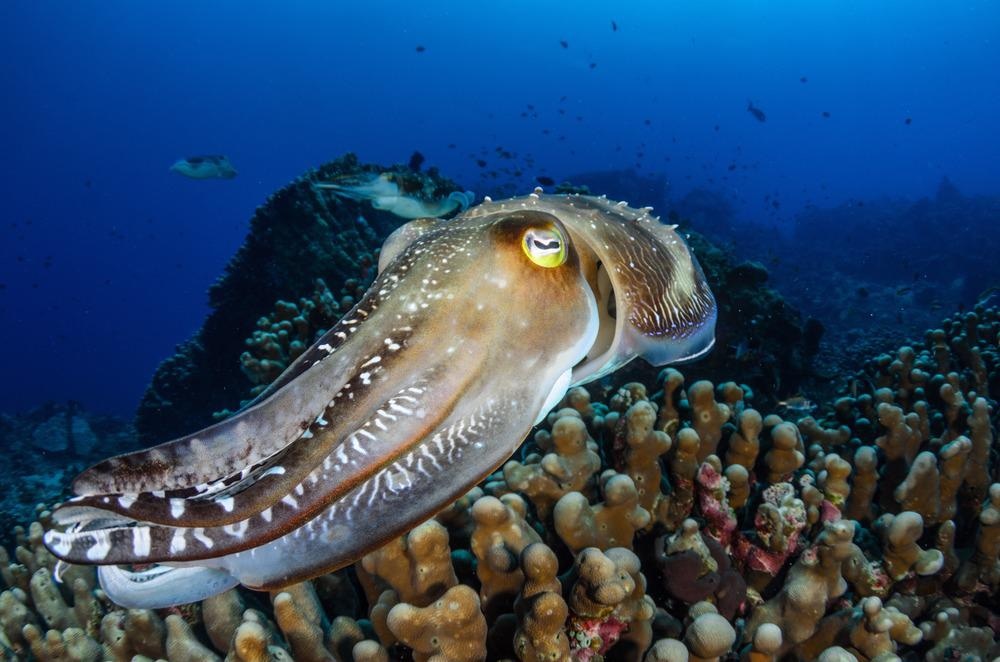In a paper recently printed in the journal ACS Applied Materials & Interfaces, to imitate the photonic reaction of squid skin, researchers sequenced, recombinantly produced, and self-assembled reflective proteins from Sepioteuthis. lessioniana into spherical nanoparticles by combining reflectin B1 with a click chemistry ligand.

Study: Cephalopod-Mimetic Tunable Photonic Coatings Assembled from Quasi-Monodispersed Reflectin Protein Nanoparticles. Image Credit: Mekan Photography/Shutterstock.com
Taking Inspiration from Cephalopods
Cephalopods (cuttlefish, squids and octopuses) are natural camouflage masters. They use metachrosis to adaptively regulate the morphology of dermal cells, iridophores and chromatophores to control body coloration as well as body patterns. Bragg reflectors, which utilize thin-film constructive interference and periodic spacing of photonic crystals, are frequently used in iridescent light-refractive and reflective materials.
Squids belonging to Loliginidae family, including S. lessioniana, the subject of this study, have the unusual ability to tune and control the internal construction and regularity of Bragg-like reflector platelets contained within iridophores, which are completely made of proteins known as reflectins. The consequent dynamic iridescence is a wavelength and angle-dependent reflection that produces a wide range of bright colors.
Earlier studies have shown that the phosphorylation/dephosphorylation of condensed reflectin nanoparticles in reflector platelets controls these adaptive photonic properties. Phosphorylation rapidly transmits negative charges to positively charged reflectins, leading to the neutralization of charge and reduction in nanoparticle size, and subsequently a blue shift in wavelength emission.
Controlling the Size of Reflectins can Control their Color
Due to their unique features, reflections have been utilized to generate structurally colored bio-photonic substrates. It has been recently reported that full-length reflectins can self-assemble into well-controlled nanoparticles and then be integrated into photonic coatings.
It was hypothesized that the color of coatings/films composed of recombinant reflectin nanoparticles could be controlled by neutralizing them into photonic structures and regulating their size.
Key Features of the Research
The development of reflectin-based nanoparticles was regulated for the first time in this study by presenting the DBCO-Sulfo-NHS ester and merely changing the post-purification dialysis parameters with ACN. The approach for conjugation and self-assembly was centered around fundamental colloidal chemistry and was carried out under specific conditions, including ambient pressure, physiological circumstances (pH 7.0) and room temperature.
The click chemistry ligand offered many advantages. The size of the nanoparticles could be controlled with quasi-monodispersity. The DBCO synthesized protein nanoparticles were click-chemistry set, allowing a wide range of ligand conjugates to change the photonic reactivity and surface chemistry.
The results showed that DCBO bounded SlRF-B1 can self-assemble into nanoparticles of diverse sizes with a regulated size distribution. The production of large particles also enabled the researchers to learn more about protein coalescence and the self-assembly process of reflectins.
Modulating the Desired Colors
The monolayer films with nanoparticle sizes ranging from 170 to 310 nm provided structural colors ranging from blue to near-infrared. The higher-order maximum did not obstruct the 270 nm nanoparticles red sample because it was in the UV area. When the size of nanoparticle was equal to the observable wavelength, single particle scattering properties were observed.
The higher-order resonance peak with greater optical captivity changed into the blue wavelength region for the coatings of 660 nm nanoparticle, hence red architectural coloration was not detected. A deep red color coating was achieved by combining 660 nm nanoparticles with coumarin 343X azide, a method that replicates the function of xanthommantin in squid chromatophores.
Advantages and Applications of the Developed Photonic Coatings
Coatings made with click chemistry immobilization remained durable at room temperature for more than a year without requiring special storage. The study was able to show time-resolved self-assembly of reflectin nanoparticles thanks to the single molecule ligand DBCO-Sulfo-NHS ester's ability to trigger regulated nanoparticle development.
Overall, this research establishes a larger area for protein-based photonic nanostructures in optoelectronic sensors and displays, with the potential to be extended to other sectors such as nanocarriers for regulated drug administration.
Since the coatings can be tailored to reflect near-infrared light, it is possible for them to be helpful for commercial uses in window coatings in tropical environments, reducing infrared absorption and lowering the carbon footprint of air conditioning equipment.
Reference
Loke, J. J., Hoon, S., & Miserez, A. (2022). Cephalopod-Mimetic Tunable Photonic Coatings Assembled from Quasi-Monodispersed Reflectin Protein Nanoparticles. ACS Applied Materials & Interfaces. Available at: https://doi.org/10.1021/acsami.2c01999
Disclaimer: The views expressed here are those of the author expressed in their private capacity and do not necessarily represent the views of AZoM.com Limited T/A AZoNetwork the owner and operator of this website. This disclaimer forms part of the Terms and conditions of use of this website.